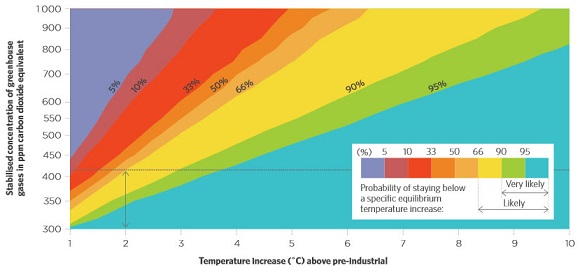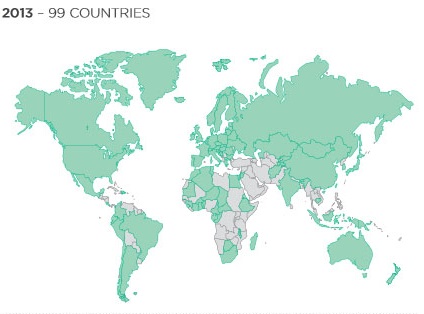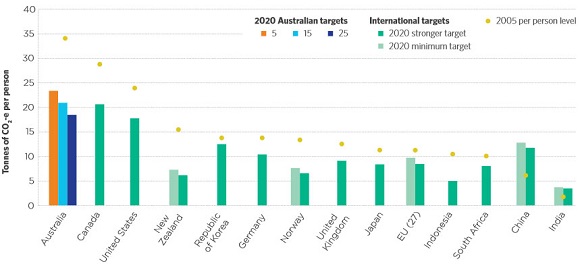 Last month the Climate Change Authority published a Draft Report of its Targets and Progress Review, which is to be completed by February 2014.
Last month the Climate Change Authority published a Draft Report of its Targets and Progress Review, which is to be completed by February 2014.
Submissions to the Draft Report must be lodged on this webpage by 29 November 2013.
The full draft report (all 265 pages) is downloadable from the first link above. Unfortunately I don’t have time to read all of it, so I’ve reproduced below the summary of the Executive Summary provided by the Authority, with some slight enhancements.
This Review can inform upcoming decisions on international commitments, guide long-term investment decision-making and inform the design of the Government’s Direct Action Plan.
The Authority’s views are grounded in science which says the world needs a long-term limit on emissions to stay below 2 degrees of warming and reduce risks of dangerous climate change. Australia also needs to take a long term view of emissions and set a 2050 emissions budget.
The Authority has also considered international action on climate change which shows a clear trend towards more ambitious action, although all countries need to do more.
The Authority has considered the economic implications of stronger targets and has concluded that it is possible to move to stronger targets at relatively small cost to the economy. The Authority’s draft recommendations seek to balance short term clarity and stability with longer term flexibility by recommending a single 2020 target and a trajectory range to 2030.
The Authority considers a 5 per cent target for 2020 to be inadequate because the Government’s [own] conditions [for moving beyond 5 per cent appear to have been met] and the pace of international action justifies us going further. [It] is inconsistent with action towards the 2 degrees goal and more ambitious targets might now be easier to achieve than earlier thought.
The Authority presents two targets for 2020 – 15 per cent and 25 per cent, with different trajectory ranges to 2030 [35 to 50 per cent and 40 to 50 per cent respectively].
Compared with 25 per cent, 15 per cent would require faster reductions later, and would use up more of the [carbon] budget sooner. [It] would place us in the middle of the pack on climate change action and would cost slightly less in the short term.
Australia can use international emissions reductions to help meet its target. While we have many domestic opportunities to reduce emissions, allowing international emissions reductions to be part of the mix can help lower costs. The Government should consider allowing the use of international emissions reductions to go beyond 5 per cent.
The Authority seeks feedback on this Draft report to inform its deliberations on final recommendations.
Clearly the Abbott Government will take no notice of the Review. In fact they have specifically reneged on the extended 5 to 25% range which had been bipartisan policy since 2009.
In fact we may achieve better than 5% without too much government effort. In the Executive Summary (page 4 on the counter) we are told that during the 2008-2012 period we accrued 91MT CO2-e in credits under the Kyoto Protocol which can be carried forward. Then this:
Official projections made in 2012 indicated that 754 Mt CO2-e of emissions reductions were required in the period to 2020 to deliver the 5 per cent reduction target. On current estimates, the same level of emissions reductions would be equivalent to an 11 per cent reduction. Taking into account the Kyoto ‘carry over’ equivalent to 91 Mt CO2-e, this would imply a 14 per cent reduction by 2020.
The Authority appears to favour the 25% option, which yields a smoother path. It costs only $2.7 billion pa more (0.16% of GDP). With 15% you need accelerated effort after 2020.
My impression of the report is very favourable. Scientifically it appears sound. Economically they appear to have covered all bases, including trade implications.
The progress made to date has been because of changes in the balance within the economy from heavy manufacturing to services, a diminution in land clearing, and the impact of renewables and other factors in the electricity sector. Since 1990 our GDP has doubled while emissions have remained pretty much the same.
The authority understands that there is considerable risk in the 2% target stabilisation scenario and contemplated moving to 1.5C. They stuck with 2C because that is where the action is internationally. On page 42 they published this wondrous graph:

The source has Meinshausen’s name on it, so it’s got to be OK.
It shows the probability of staying below specific temperature increases, given different CO2e stabilisation levels. The line is drawn at 415, which in terms of CO2 equivalents we have already passed. To me the graph confirms the merits of the 350.org campaign. The Authority is aware that net negative emissions will probably be necessary later in this century.
Abbott and company are becoming quite annoying in suggesting that there is no action internationally. The Authority noted that there were 99 countries with ‘Copenhagen’ commitments covering over 80% of the planet’s emissions. This map shows the extent:

Then this graph shows how our targets fit with those of some of a selection of relevant countries.

Sorry I can’t get a clearer image. It’s on page 65 of the report. The dots show the per capita emissions at 2005 levels. Notice that both China and India will increase per capita emissions. Even at 25% we are not in danger of getting out in front of what needs to be done.
Especially pleasing was the Authority’s use of the carbon budget approach. They determined Australia’s budget as 10,100 MT CO2e for the period 2013 to 2150. A 15% target would use 4,324 MT by 2020, leaving only 5776 MT for the following 30 years. If we were really serious we would be going for 45 to 50% by 2050.
The review will have two values beyond the academic, in my view. Firstly, it should provide guidance for Labor and the Greens, looking forward to the time when the adults are back in charge. Secondly, I think other countries could look at the approach adopted as something of a model. Certainly it would stimulate their own thinking about how to plan stabilisation of emissions.

It is all very well to talk about 2020 targets but the problem is that, at times, both sides of politics seem to assume that actually doing something to meet these targets can be left to 2019. For example, an EU linked ETS is unlikely to produce a carbon price big enough to drive significant climate action for yeays and may still be disfunctional when 2020 is reached.
What we need from both sides is a statement of tangible outcomes that they would want to achieve in this term of parliament. Tangible in this context means things like increased renewable power capacity etc. It doesn’t mean introducing a Claytons ETS or a Clayton’s direct action plan.
I cannot see your claim that Australia has anything to offer in guidance from an Authority in its graphical presentation suggests ,Australians are world major culprits,and you use that graphical presentation just before you conclude.That is per capita stuff is the hallmark in this case,of even the authority figures without even them as an exception, are creating the problem.A simple heuristic comes to mind.Why do you want to accept an Authority’s figures [which then include themselves living their lives in this presentation,when clearly neither them as officials or] yourself as a person who is willing to agree with something that is essentially a preposterous notion!?Neither you or the Authority is wrong in being concerned if the phenomena actually exists outside of graphical presentations,but the solution to that as a problem will not be solved by a graphical presentation with the same inputs varied ,meaning the individual has reduced their own target so much that CO2 magically disappears from measurements.I know this may seem insulting to you,but,I do not think this Authority has done anything useful.More so, as I have personally found when presenting the overlooked fact of CO2 the gas,under pressure similar to pressurization to other gases behaves in a distinctly different manner.The problem then,if gas, is much more simple then the boundless energy involved in accounting for expanding gas in the atmosphere behaving to its own feral nature.The problem really of CO2 is whence was it part of before emissions!?In the case of coal mining,how to stop the small number of those electricity producers allowing no evaluation of the burning in a manner that exercises no common sense,in converting the CO2 to usefulness.As in algae growing for fuel and other purposes,which may include glue.Glue that maybe useful in stopping topsoil drift.Rather than reducing the role of the grid in these matters of restraining the feral gas,and associated particles and other toxins,the need to expand grid electricity use is more practicable.That is a scientific pursuit to apply electric current in a number of ways direct to soil,subsoil and even rock under soil.In drought the friable nature of the soil is lost,and worms microbes insectivora are all reduced.In flood ,for other reasons the health of the soil isn’t that great.Some lessons from fracking could be applied to disturbed soils that have undergone biota clearance and farming method.That is ,there simply isn’t enough research into geological matters of farm and public and private lands generally at soil level and below across Australia’s terrain.Where the grid exists nearby,and unexploited,as poles pylons and other direct possibilities.One does not have to accept that a tree cannot be disturbed once its large roots are establish in rocky conditions deep below the upper soil type.Getting down in there and giving the rocks a shake,plus connecting ground water to surge towards root system penetration,isn’t beyond humanity,and isn’t dulling the ecological approach.Mine sites in the terrain maybe more useful than what they may appear to be.Simply,an overview of electricity use may actually lead directly to CO2 being deposited below the potential of regular disturbed soils,but still safely there,including in mine sites themselves,because after all, the capture of CO2 requires legitimate places to keep an eye on it directly.The oddity of as yet,the mining interests and the pyrolysis interests not combining with the grid supplied electricity, to see if the basic human requirement to use this CO2 released as close as possible to a form pre release,is the sadness of the political interests,somehow creating conditions,where the non painfully obvious can flourish.CO2 has become a fashion item under the over exposed intrigues of the election calendar,and Australian scientists are not to be seen objecting.Conformity rules the day,in a political sheep manner.
I doubt my opinion is the last word on the subject.If it put people off commenting, apologies! They were merely suggestions,and as yet,lacking the description of activities in action.My judgements were not about Brian and his sense of the Authority,but how I think coalescing around that Authority as a view, maybe very badly mistaken viewed in the light of individual responsibility.
John D, there was an excellent chapter in the Centre for Policy Development’s tome Pushing our Luck by John Wiseman which gave a framework for tackling climate change on a government/societal basis. I’d been hoping to do a post on it.
Sometime soon, maybe.